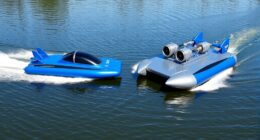To execute a 360º spin without losing altitude, maintain a controlled airspeed just above stall speed, and use smooth, coordinated inputs—opposite rudder and slight back pressure—to initiate and sustain the spin. Keep the wings and attitude steady, adjusting gently if altitude begins to decrease. Focus on managing airflow and rotational speed to keep lift consistent. If you want to master this maneuver perfectly, there’s more to discover about controlling every aerodynamic detail.
Key Takeaways
- Initiate the spin at a controlled, slightly above stall speed with gentle, coordinated rudder and elevator inputs.
- Maintain a steady, moderate rotational rate to ensure airflow stability and consistent lift.
- Keep the aircraft’s pitch attitude just above the horizon during the spin to sustain altitude.
- Make smooth, incremental control adjustments if altitude begins to decrease, avoiding abrupt movements.
- Gently recover by neutralizing controls, leveling the wings, and pushing the nose forward to exit the spin smoothly.

Performing a 360º spin without losing altitude requires precise control and proper technique. To achieve this, you need to understand the aerodynamic principles at play and apply them with skillful pilot technique. The key lies in managing your aircraft’s lift, drag, and attitude throughout the maneuver, ensuring a smooth rotation without unnecessary altitude loss.
First, familiarize yourself with the aerodynamic principles involved. During a spin, the aircraft’s angle of attack and airflow change dramatically. To maintain altitude, you must keep the wings generating sufficient lift. This means initiating the spin at a controlled airspeed, ideally slightly above stall speed, to ensure your plane remains in controlled flight. As you begin the maneuver, use gentle, coordinated inputs—applying opposite rudder to start the spin and slight back pressure on the stick to maintain the pitch attitude. Throughout, your goal is to keep the airplane’s attitude steady, preventing excessive nose-up or nose-down angles that could cause altitude loss or stall.
Your pilot technique plays a crucial role here. Use smooth, deliberate movements—abrupt inputs disrupt airflow and can cause altitude fluctuations. As you initiate the spin, ensure your controls are coordinated: a gentle amount of rudder to start the rotation, combined with subtle aileron inputs to keep the spin centered. Keep your eyes on your attitude indicator and altimeter to monitor the aircraft’s attitude and altitude. During the spin, maintain a consistent pitch attitude—often just above the horizon—and avoid excessive control inputs that could unbalance the aircraft. Developing a good sense of aerodynamic control is essential for executing the maneuver smoothly.
As the spin progresses, focus on maintaining a constant rotational rate. This consistency helps you manage the airflow over the wings, keeping the lift steady. If you notice altitude starting to decrease, slightly adjust the pitch or reduce the rotation rate, but do so smoothly. When you’re ready to recover, reverse the inputs carefully: neutralize the rudder, level the wings, and gently push the nose forward to break the stall and regain normal flight. Proper pilot technique involves calm, precise control movements and a good understanding of how aerodynamic principles influence your aircraft during the spin.
In essence, executing a perfect 360º spin without losing altitude hinges on understanding the aerodynamic principles that govern lift and airflow and applying disciplined pilot technique. With practice, you’ll develop the feel for the right inputs to keep the aircraft balanced and controlled throughout the maneuver, ensuring a clean, controlled spin that stays as close to level flight as possible.
Frequently Asked Questions
What Aircraft Types Are Best Suited for 360º Spins?
When considering aircraft types for a 360º spin, focus on those with excellent maneuverability and responsive controls, like aerobatic planes or light sport aircraft. These aircraft handle spins better and allow for more controlled maneuvering. Make certain you’re familiar with spin recovery techniques tailored to your aircraft. Practicing in suitable aircraft ensures you can perform spins safely, maintaining altitude and control throughout the maneuver.
How Does Wind Affect Spin Stability and Altitude?
Wind substantially impacts spin stability and altitude because weather influence alters spin aerodynamics. As you perform a spin, strong or gusty winds can cause unpredictable yaw and pitch movements, making it harder to maintain control. You might lose altitude more quickly or find your spin less stable. Always check weather conditions before executing spins, and anticipate wind effects to keep the aircraft controlled and safe throughout the maneuver.
What Safety Precautions Are Necessary During a Spin?
During a spin, you should always prioritize safety by practicing proper spin entry techniques and knowing emergency recovery procedures. Make sure to perform spins in a designated area, stay within your skill level, and use correct control inputs to maintain control. Always be prepared to initiate recovery steps promptly if the spin becomes unintentional or unsafe. Staying calm and following established procedures helps prevent accidents and guarantees a safe, controlled recovery.
Can Pilots Recover From a Spin at Low Altitude?
Think of a low-altitude spin as a ticking clock—you need quick action to avoid disaster. You can recover from a spin at low altitude if you perform proper stall recovery techniques swiftly, focusing on altitude preservation. Pull the control stick firmly and smoothly to break the stall, then level the wings. Remember, the key is decisive, precise movements to regain control before hitting the ground.
Are There Specific Training Programs for Mastering Spins?
You should explore specialized training programs that focus on spin recovery techniques. These programs teach you how to recognize spins early and respond effectively, ensuring safety and control. Through simulation sessions and expert guidance, you’ll develop the skills needed to master spins confidently. Participating in structured training helps you understand the mechanics of spins and improves your ability to recover quickly, making you a safer pilot in challenging situations.
Conclusion
So, next time you pull off that perfect 360º spin without losing altitude, remember—it’s all about precision, not luck. Ironically, the trick to defying gravity is simply mastering your technique, not wishing for a miracle. Keep practicing, stay focused, and maybe, just maybe, you’ll surprise everyone by pulling off a flawless spin every time. After all, who knew that defying physics was just a matter of practice and a little bit of control?










